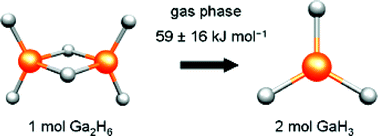Improved methods of analysis and new quantum chemical calculations have been applied to the results of earlier gas-phase electron diffraction (GED) studies of digallane to give what is judged to be the most realistic structure available to date. The principal distances (ra3,1 in pm) and interbond angles (∠a3,1 in deg) are as follows (t = terminal, b = bridging): r(Ga⋯Ga) 254.9(2), r(Ga−Ht) 155.0(6), r(Ga−Hb) 172.3(6), ∠Ga−Hb−Ga 95.4(5), and ∠Ht−Ga−Ht 128.6(9). Scrutiny of the IR spectra of solid Ar matrices doped with the vapour above solid samples of gallane at temperatures in the range 190-220 K reveals the presence of not only Ga2H6 as the major component, but also a significant fraction of the monomer GaH3. Analysis of the relative proportions of the two molecules evaporating from the solid at different temperatures has led to a first experimental estimate of 59 ± 16 kJ mol−1 for the enthalpy change associated with the reaction Ga2H6(g) → 2GaH3(g). Together with a value of 52 kJ mol−1 delivered by fresh calculations at the MP2 level, this implies that the stability of the dimer with respect to dissociation has been overrated by earlier theoretical treatments.

You have access to this article
 Please wait while we load your content...
Something went wrong. Try again?
Please wait while we load your content...
Something went wrong. Try again?


 Please wait while we load your content...
Please wait while we load your content...